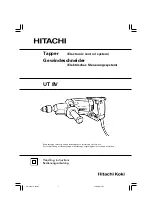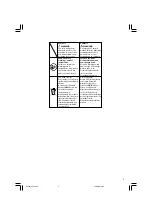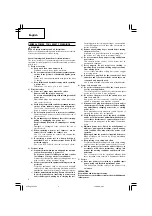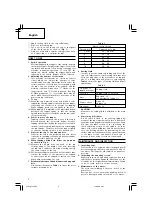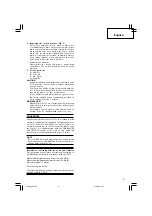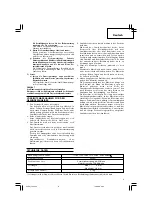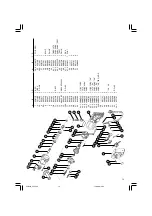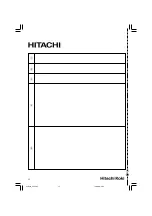
5
English
䡬
Apply cutting fluid to the tap sufficiently.
䡬
First, use preceding tap.
䡬
Cut a notch on the shank of a tap so that pawl
of the chuck can be hooked on. (
Fig. 1
)
䡬
Only use a tap with a smaller cutting torque (such
as a spiral tap or a spiral-point tap).
HOW TO USE
1. Switch operation
After pulling back the trigger of the switch, depress
the switch stopper. Even after the finger is removed,
the switch will remain ON, proving convenient for
machine continuous operation. To turn OFF the
switch, by merely pulling the trigger again and
releasing it, the switch stopper will be released.
2. Adjusting the number of revolution
This machine incorporates an electronic control
circuit which can adjust the number of tap's
revolution by non-step. Adjust the dial to select the
correct number of revolution, corresponding with
the tap's size, the material to be tapped, and the
working condition. Graduation “1” stands for the
lowest speed; and “5“ for the top speed. (See
Fig.
3
) When graduation “1“ is selected, there may be
times when the machine will not rotate due to the
power supply conditions.
3. To tap
(1) When the tap is pressed to the hole which is to be
tapped, the floating spindle is pushed into the tapper,
converting the revolution to normal for tapping.
While tapping, press the tap lightly to the hole.
(2) When tapping is completed to the prescribed depth,
pull back the tapper lightly, so that the floating
spindle turns in reverse revolution and the tap comes
off automatically.
4. Power to press the tapper
Tapping cannot be speeded up, even if the tap is
pressed beyond the necessary degree, because
tapping speed is decided by the degree of revolution.
Instead, it will result in breaking the tap or damaging
the tap threads. Therefore, press the tapper lightly
so that the floating spindle is not pushed out.
5. Conform the tap to the prepared hote.
Conform the tap to the prepared hole and insert
it directly in. Inserting it at an angle will exert undue
stress, possible breaking the tap.
6. When tapping a blind hote, follow the procedure
as shown in Fig 4.
(1) Measure the length from the head of the tap
corresponding to the depth of the hole, inserting
the tap into a rubber or vinyl tube leaving exactly
the same length as the tap.
(2) Pull back the tapper when the end of the rubber tube
touches the surface of the material to be tapped,
so that it then can be tapped to exactly the same
depth without breaking the tap.
7. Relationship between thread diameter and prepared
hole
Use the specifications in
Table 1
to create the most
suitable prepared hole.
Table 1
Metric coarse thread
Thread dia.
Prepared hole dia.
3 mm
2.5 - 2.6 mm
4
3.3 - 3.4
5
4.2 - 4.3
6
5.0 - 5.1
8
6.8 - 6.9
10
8.5 - 8.6
8. Cutting fluid
In order to get the sharp tap cutting and life of the
tap, it is important to select cutting fluid that best
suits the properties of the material to be tapped.
Use of a cutting fluid will get more easy tapping.
Table 2
shows the types of cutting fluids and their
applications.
Table 2
Properties of
tapped material
Cutting fluid
Cast iron
Cutting fluid is not used
Steel
Rapeseed oil,
non-waterbased cutting oil
Copper alloys
Light oil,
Spindle oil
Aluminum
Light oil
CAUTION
Make sure no cutting fluid is attached to the main
unit.
9. Concerning drill chucks
A drill chuck is fixed to the floating spindle by
means of the taper attachment. In case a drill chuck
should be disengaged from the unit, remove oil and
dirt from the taper section of the chuck and the
chuck attaching section of the spindle, let three
claws of the chuck withdraw, and mount the chuck
onto the floating spindle by hammering its end
surface with a wooden hammer. Pay special attention
to the taper section and handle it with care to
prevent it from being scratched or damaged.
MAINTENANCE AND INSPECTION
1. Inspecting taps
Continued use of a tap with a dull cutting edge will
decrease tapping efficiency and put extra load on
the motor. Dull taps should replaced as quickly as
possible.
2. Inspecting the mounting screws:
Regularly inspect all mounting screws and ensure
that they are properly tightened. Should any of the
screws be loose, retighten them immediately. Failure
to do so could result in serious hazard.
3. Maintenance of the motor:
The motor unit winding is the very “heart” of the
power tool.
Exercise due care to ensure the winding does not
become damaged and/or wet with oil or water.
01Eng_P20SA2
12/26/08, 9:43
5

